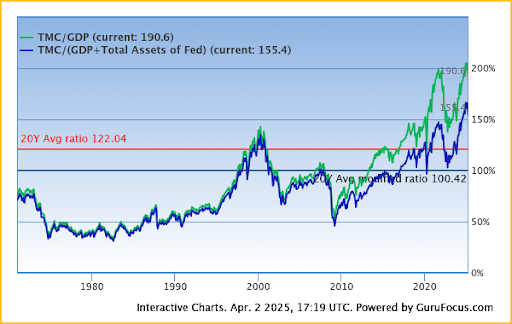What Is the Buffett Indicator?
"It is better to be roughly right than precisely wrong," writes Carveth Read in "Logic: Deductive and Inductive." That's the premise of the Buffett Indicator.


Buy low and sell high. That sounds easy, right? The problem is defining what exactly "low" means.
How do you define whether the stock market is cheap or expensive?
Precisely valuing the market is exceptionally hard. It involves making guesses on several key assumptions such as interest rates or growth in earnings per share.

Sign up for Kiplinger’s Free E-Newsletters
Profit and prosper with the best of expert advice on investing, taxes, retirement, personal finance and more - straight to your e-mail.
Profit and prosper with the best of expert advice - straight to your e-mail.
So investors – even all-time greats like Warren Buffett – tend to fall back on "quick and dirty" metrics.
These metrics are designed to tell you whether the market is generally cheap or generally expensive. But they aren't intended to be used with surgical precision.
It so happens that the "Oracle of Omaha" has his very own quick-and-dirty metric, the "Buffett Indicator." The Buffett Indicator is a broad measuring stick of whether the stock market is overvalued or undervalued relative to the size of the overall economy.
Buffett famously referred to this indicator as "probably the best single measure of where valuations stand at any given moment" in a 2001 interview with Fortune magazine.
It is absolutely not a tool for short-term trading.
But it can be a really solid tool for long-term allocation decisions, such as for a 401(k) plan or even in an institutional portfolio like a pension plan.
What is the Buffett Indicator?
The Buffett Indicator is calculated by dividing the total market capitalization of a country's publicly traded stocks by its gross domestic product (GDP). Market cap is the total value of all outstanding shares of every publicly traded company.
For example, Microsoft's (MSFT) market cap is $2.6 trillion. That's the total value of all Microsoft shares in existence. We add up every other listed company to arrive at a total market cap of a country.
If we were putting the Buffett Indicator to work in the U.S., we would use the Wilshire 5000 Total Market Index. The Wilshire 5000 includes far more companies than the commonly quoted S&P 500 Index or the Dow Jones Industrial Average.
We would divide this comprehensive measure of nearly all publicly traded American stocks by U.S. GDP.
In short, the Buffett Indicator equals total market cap divided by GDP. Its utility is based on the idea that, over time, stock values should roughly move with the economy.
When this ratio is high, it suggests that the market's valuation is running ahead of the actual economic output, meaning the market is potentially overvalued. A low ratio could indicate undervaluation and possibly a good buying opportunity.
It's important to note that the number in a vacuum doesn't mean much. There is no absolute level that means the market is cheap or expensive. You have to compare it over time and look for trends.
Historically, the Buffett Indicator has hovered around 75% to 90%. Values above 100% may suggest the stock market is overvalued, although some argue that changes in interest rates, profit margins and globalization have shifted what counts as a "normal" ratio.
The Buffett Indicator has certainly trended higher over the past few decades.
The Buffett Indicator in action
Let's take a look at the Buffett Indicator today.
Research site GuruFocus calculated the traditional Buffett Indicator (green line) along with a modified Buffett Indicator (blue line) that attempts to adjust for the Federal Reserve's aggressive monetary policy since the 2008 meltdown.
Here's what that looks like in chart form:

A few things jump right off the chart.
If 100% is Buffett's rule of thumb for overvaluation, then the market has spent most of the past 20 years in exceptionally expensive territory. The average has been 122%.
Of course, today we're well above that level.
Even after the recent stock correction, the traditional Buffett Indicator is above 190%. And the Fed-adjusted Buffett Indicator is sitting at 155%.
When Buffett endorsed it in Forbes, the ratio had soared to record highs during the dot-com bubble. The indicator fell in the early 2000s following the market crash.
But it has climbed steadily in the decades since, often reaching levels well above its historical average.
Takeaways from the Buffett Indicator
Does the Buffett Indicator’s lofty level suggest a market crash is imminent? No, and that's not how the indicator is designed to be used.
It's exceptionally poor as a short-term timing tool. Had you dumped your stocks due to overvaluation in the index, you would have missed out on one of the longest and most extreme bull markets in history.
But it's a useful tool for understanding where we are in the broader market cycle. You should use it as you balance your portfolio between stocks, bonds, cash, gold and other assets.
If you're heavily invested in stocks right now, you might want to look at diversifying your portfolio by upping your exposure to other asset classes.
And, likewise, when the indicator dips into "cheap" territory, you might consider increasing your exposure to stocks.
Related content
Get Kiplinger Today newsletter — free
Profit and prosper with the best of Kiplinger's advice on investing, taxes, retirement, personal finance and much more. Delivered daily. Enter your email in the box and click Sign Me Up.

Charles Lewis Sizemore, CFA is the Chief Investment Officer of Sizemore Capital Management LLC, a registered investment advisor based in Dallas, Texas, where he specializes in dividend-focused portfolios and in building alternative allocations with minimal correlation to the stock market.
-
 This One Area of Americans' Retirement Readiness Gets a Bad Grade
This One Area of Americans' Retirement Readiness Gets a Bad GradeMillions of Americans score poorly on retirement readiness due to this Achilles' heel. Are you prepared?
By Christy Bieber Published
-
 REAL ID Deadline: What You Need by May 7, 2025
REAL ID Deadline: What You Need by May 7, 2025Worried about needing a REAL ID soon? Learn more about the requirement, how to get your ID and valid REAL ID alternatives.
By Laura Gariepy Published
-
 10 Major AI Companies You Should Know
10 Major AI Companies You Should KnowThese 10 AI companies are at the forefront of machine learning. Find out how they’re driving innovation and jostling to be the biggest players in the game.
By Tom Taulli Published
-
 How Baby Boomers and Gen Xers Are Redefining Retirement Living
How Baby Boomers and Gen Xers Are Redefining Retirement LivingBoth generations need to embrace change and leverage real estate as a dynamic asset in their retirement planning. Here's how financial advisers can help, too.
By David Conti, CPRC Published
-
 How Good Advisers Manage Risk in Challenging Markets
How Good Advisers Manage Risk in Challenging MarketsThey understand the difference between what might be real challenges to an investor's strategy and fear brought on by market volatility.
By Ryan L. Kirk, CFA® Published
-
 Financial Planning's Paradox: Balancing Riches and True Wealth
Financial Planning's Paradox: Balancing Riches and True WealthWhile enough money is important for financial security, it does not guarantee fulfillment. How can retirees and financial advisers keep their eye on the ball?
By Richard P. Himmer, PhD Published
-
 A Confident Retirement Starts With These Four Strategies
A Confident Retirement Starts With These Four StrategiesWork your way around income gaps, tax gaffes and Social Security insecurity with some thoughtful planning and analysis.
By Nick Bare, CFP® Published
-
 Should You Still Wait Until 70 to Claim Social Security?
Should You Still Wait Until 70 to Claim Social Security?Delaying Social Security until age 70 will increase your benefits. But with shortages ahead, and talk of cuts, is there a case for claiming sooner?
By Evan T. Beach, CFP®, AWMA® Published
-
 Retirement Planning for Couples: How to Plan to Be So Happy Together
Retirement Planning for Couples: How to Plan to Be So Happy TogetherPlanning for retirement as a couple is a team sport that takes open communication, thoughtful planning and a solid financial strategy.
By Andrew Rosen, CFP®, CEP Published
-
 Market Turmoil: What History Tells Us About Current Volatility
Market Turmoil: What History Tells Us About Current VolatilityThis up-and-down uncertainty is nerve-racking, but a look back at previous downturns shows that the markets are resilient. Here's how to ride out the turmoil.
By Michael Aloi, CFP® Published